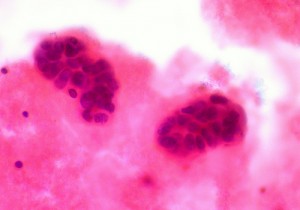
Breast cancers that start off vulnerable to hormone-based treatments often lose that vulnerability over time. A protein called ADAM12 is being developed into a diagnostic and prognostic biomarker, and might also hold the key to treating women with such tumors. (Illustration: Durer’s “Adam and Eve")
About two-thirds of breast cancers are fueled by estrogen, making them quite vulnerable to drugs like tamoxifen that interfere with the hormone. But some 50 percent of such hormone-sensitive tumors start shrugging off tamoxifen treatment at some point and continue to grow.
Marsha Moses and her team in Children’s Vascular Biology Program want to turn the tide against these estrogen- or hormone-independent tumors, which are much more difficult to treat. And they think a protein named Adam – or rather, ADAM12 – might hold the key.
The story starts seven years ago with a search for cancer biomarkers in a fluid far removed from the breast: urine. Over the years, Moses, the program’s director, has collected a large biorepository of human urine and other samples, as well as associated clinical data, which she and her lab use to search for proteins whose presence is associated with different cancers.
In 2004, Moses and her postdoctoral fellow Roopali Roy discovered that the amount of ADAM12 rises in the urine of women with breast cancer as their cancer progresses. “What struck us was that we could almost use the amount of ADAM12 in a woman’s urine to predict the stage of her cancer,” Moses says. “It goes up dramatically as tumors become more invasive.”
What’s more, they found that ADAM12 appears more frequently in the urine of breast cancer patients than in healthy women.
Armed with this knowledge, Moses and her collaborators next asked whether ADAM12 could be a marker for cancer risk. In 2008, they announced that a woman’s urine ADAM12 level was almost as good a means of predicting her cancer risk as the Gail model, a popular history-based risk assessment tool.
“The two synergized,” Moses says. “If you combine ADAM12 screening with Gail, you could actually make Gail a more effective tool. What all of this told us was that the protein is there in women with breast cancer, and that it’s predictive of risk and stage. But what we wanted to know was: Is it doing something? Does it play an active role in breast cancer?”
Before answering this question, let’s step back for a moment and talk about ADAM12 itself. It actually comes in two forms. Its short form, ADAM12-S, is an enzyme that is released from the cell and chews up or degrades the extracellular matrix (the web of proteins that help hold cells in place within their home tissues) so that cells can move around. In this way, it helps with processes like wound repair, angiogenesis, and, in the case of cancer, metastasis. ADAM12-L, the enzyme’s long form, is anchored to cell surfaces, where it helps pass signals from outside to within cells, among other things.
In women, ADAM12 is rarely present in normal tissues except during pregnancy, and then only in the placenta. Cancer cells often exploit members of the ADAM12 family, which can be found in the urine of patients with a variety of cancers.
Both the S and L forms, it seems, are active players in breast tumors.

These metastatic breast cancer cells might not be able to stand up to treatments against ADAM12. (euthman/Flickr)
In two recent papers, Moses, Roy, and their colleagues made two discoveries: First, goading hormone-sensitive breast cancer cells into overproducing both forms of ADAM12 releases them from their reliance on estrogen. Second, ADAM12-S makes it easier for cancer cells to break free of their original tumor and spread.
“ADAM12 turns out to be quite capable of promoting hormone-independent breast cancer cell growth by itself,” Moses explains. “You can take estrogen away from the cells and add ADAM12, and the cells will keep going.”
The fact that ADAM12 is both a driver and a marker of breast cancer gives Moses and her colleagues an opportunity to developed combined treatment and companion diagnostics targeting the protein. Companion diagnostics are tests that look at biomarkers tied to specific treatments. As our knowledge of cancer’s molecular basis grows, such treatment-diagnostic combinations are becoming quite popular with the pharmaceutical industry and the Food and Drug Administration.
Children’s has licensed some of Moses’s urine biomarker discoveries, including ADAM12, to a diagnostics company, which is developing them into diagnostic and prognostic test kits. Moses is also optimistic about the enzyme’s potential as a treatment target. “It may be that targeting estrogen and ADAM12 at the same time from the start of treatment could help avoid hormone resistance and give women a better prognosis,” Moses says. “ADAM12 is showing up in some other cancers as well, and so we are hopeful that what we are learning of its roles in breast cancer could have broader impact.”







